
The Crassulaceae, also known as the stonecrop family or the orpine family, are a diverse family of dicotyledon flowering plants characterized by succulent leaves and a form of photosynthesis, known as Crassulacean acid metabolism (CAM). Flowers generally have five floral parts. Crassulaceae are usually herbaceous but there are some subshrubs, and relatively few treelike or aquatic plants. Crassulaceae are a medium-sized monophyletic family in the core eudicots, among the order Saxifragales, whose diversity has made infrafamilial classification very difficult. The family includes approximately 1,400 species and 34–35 genera, depending on the circumscription of the genus Sedum, and distributed over three subfamilies. Members of the Crassulaceae are found worldwide, but mostly in the Northern Hemisphere and southern Africa, typically in dry and/or cold areas where water may be scarce, although a few are aquatic.
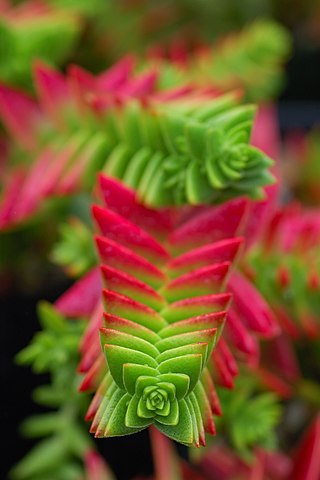
Crassula is a genus of succulent plants containing about 200 accepted species, including the popular jade plant. They are members of the stonecrop family (Crassulaceae) and are native to many parts of the globe, but cultivated varieties originate almost exclusively from species from the Eastern Cape of South Africa.

Crassula tetragona is a succulent plant native to Southern Africa. It is widely distributed from the Orange River boundary of Namaqualand to beyond the Kei River in the Eastern Cape. "Tetragona" comes from the phyllotaxy of the leaves. It is popularly named the "miniature pine tree" among ornamental plant enthusiasts, for its popular use as a "pine tree" in Bonsai.
Crassula colorata, the dense pigmyweed or dense stonecrop, is an annual plant in the family Crassulaceae. The species is endemic to Australia, occurring in Western Australia, South Australia, New South Wales and Victoria.
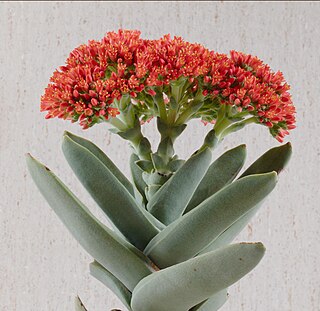
Crassula perfoliata var. falcata, known by the common names airplane plant and propeller plant, is a succulent plant endemic to South Africa, from the Cape of Good Hope.
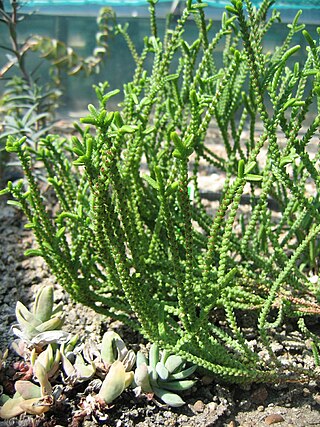
Crassula muscosa, synonyms Crassula lycopodioides and Crassula pseudolycopodioides, is a succulent plant native to South Africa and Namibia, belonging to the family of Crassulaceae and to the genus Crassula. It is a houseplant grown worldwide and commonly known as rattail crassula, watch chain, lizard's tail, zipper plant and princess pines.

Crassula capitella, is a perennial succulent plant native to southern Africa.
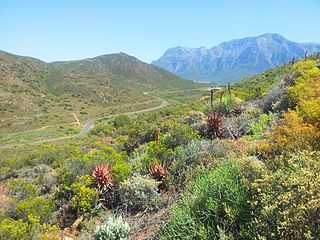
Robertson Karoo is a semi-arid vegetation type, restricted to sections of the Breede River Valley, Western Cape Province, South Africa. It is a subtype of Succulent Karoo and is characterised by the dominance of succulent plant species, and by several endemic plants and animals.

Crassula nudicaulis is a succulent plant native to South Africa, and Lesotho.

Crassula cotyledonis is a succulent plant endemic to the arid Namaqualand and Karoo regions of South Africa.
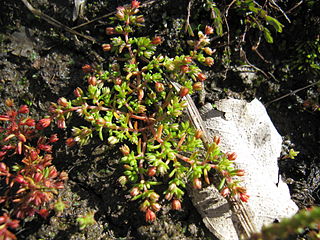
Crassula decumbens, commonly known as rufous stonecrop, cape crassula or spreading crassula, is a herb in the family Crassulaceae that is native to southern parts of Australia, South Africa, and Chile. There are generally two accepted varieties: Crassula decumbens var. decumbens and C. decumbens var. brachyphylla.
Crassula natans, commonly known as floating pigmyweed, is a herb in the family Crassulaceae.
Hellmut R. Toelken is a South Australian botanist. He retired in December 2008 from the position of senior biologist at the State Herbarium of South Australia, but remains an honorary research associate. Earlier he was with the Botanical Research Institute, Department of Agricultural Technical Services, Pretoria, S Africa.

Crassula subaphylla is a succulent plant belonging to the family Crassulaceae. It is widespread in the Karoo regions of South Africa and Namibia.
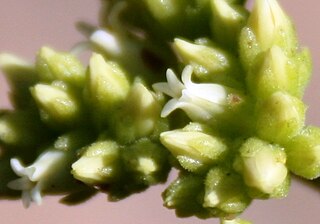
Crassula atropurpurea is a succulent plant, very common and widespread in the southern Karoo regions of South Africa and Namibia.

Crassula perfoliata is the type species of the genus Crassula, in the succulent/flowering plant family Crassulaceae, where it is placed in the subfamily Crassuloideae. Formally described by Linnaeus in 1753 as one of 10 species of Crassula, the plant is endemic to Southern Africa, where it may be found in Eswatini, Mozambique, South Africa and Zimbabwe.

Crassula setulosa is a species of stonecrop in the family Crassulaceae. It is found mostly in eastern South Africa and Lesotho.
This page is based on this
Wikipedia article Text is available under the
CC BY-SA 4.0 license; additional terms may apply.
Images, videos and audio are available under their respective licenses.














